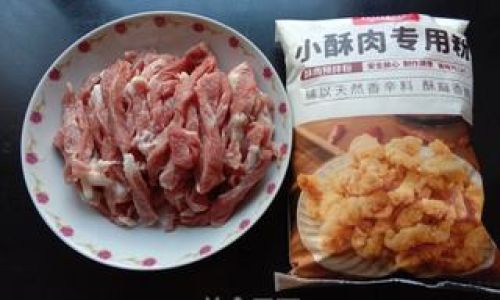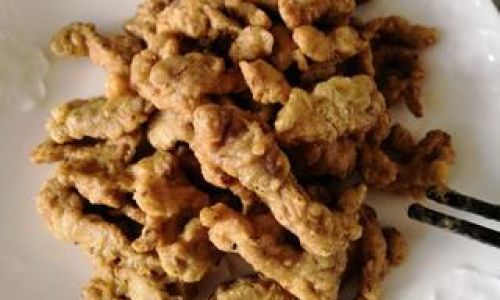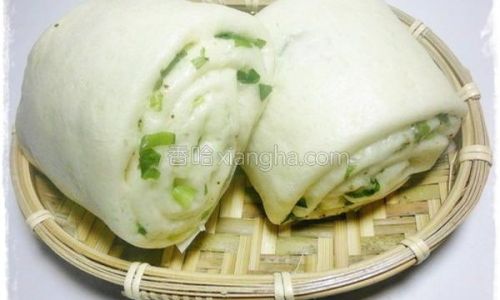Introduction
Crispy pork belly, known in Chinese cuisine as 脆皮小酥肉 (cuì pí xiǎo sū ròu), is a beloved dish that tantalizes taste buds with its irresistible combination of crackling skin, tender meat, and aromatic seasoning. This culinary masterpiece, often served as an appetizer, snack, or main course, has gained global popularity for its satisfying texture and bold flavors. Achieving the perfect balance of crispiness and juiciness requires precision, patience, and a deep understanding of cooking techniques. In this comprehensive guide, we will explore the art of making 脆皮小酥肉 from scratch, covering ingredient selection, marination methods, frying techniques, and expert tips to elevate your dish to restaurant-quality perfection.

The Science Behind Crispiness
Before diving into the recipe, it’s essential to grasp the science behind achieving that coveted crunch. The crispy texture of pork belly comes from two key factors: rendering fat and creating a dry, porous coating. When pork belly is cooked at high temperatures, the fat beneath the skin melts (renders), leaving behind air pockets that contribute to lightness. Simultaneously, a well-prepared batter or coating dehydrates during frying, forming a golden, brittle shell. Mastering these elements ensures a dish that shatters with each bite while keeping the meat moist and flavorful.
Ingredients: Quality Matters
Selecting the right ingredients is the foundation of a great 脆皮小酥肉. Here’s a breakdown of what you’ll need:
- Pork Belly (500g): Opt for fresh, high-quality pork belly with a even fat-to-meat ratio. The skin should be intact and free of blemishes.
- Marinade:
- 2 tbsp light soy sauce (for umami depth)
- 1 tbsp dark soy sauce (for color)
- 1 tbsp Shaoxing rice wine (or dry sherry)
- 1 tsp five-spice powder (star anise, cinnamon, cloves, fennel, Sichuan pepper)
- 1 tsp garlic powder (or 3 garlic cloves, minced)
- 1 tsp ginger powder (or 1-inch fresh ginger, grated)
- 1 tsp white pepper
- 1 tbsp honey (or sugar)
- Coating:
- ½ cup all-purpose flour
- ¼ cup cornstarch (adds extra crispiness)
- 1 tsp baking powder (creates airiness)
- 1 tsp salt
- 1 tsp black pepper
- Oil for Frying: Use a neutral oil with a high smoke point, such as peanut or vegetable oil.
- Optional Garnishes:
- Fresh cilantro
- Sliced green onions
- Chili flakes or Sichuan peppercorns for heat
Step-by-Step Preparation
Preparing the Pork Belly
- Skin On: Retain the skin for maximum crispiness. Use a sharp knife to score the skin in a diamond pattern, cutting about ¼-inch deep. This allows heat to penetrate and fat to render evenly.
- Trim Excess Fat: While some fat is desirable, remove any thick layers to prevent greasiness.
- Cube the Meat: Cut the pork belly into 1.5-inch cubes, ensuring uniform size for even cooking.
Marinating for Flavor
In a large bowl, combine the pork belly cubes with the marinade ingredients. Massage the mixture into the meat, ensuring every piece is coated. Cover and refrigerate for at least 2 hours (or overnight for deeper flavor). The marinade not only seasons the meat but also begins the process of tenderizing it.
Creating the Perfect Coating
The coating is where magic happens. In a shallow dish, whisk together the flour, cornstarch, baking powder, salt, and pepper. For an extra layer of complexity, add a pinch of five-spice powder or chili flakes. Dredge each marinated pork cube in the dry mixture, pressing gently to adhere. Shake off excess coating—this prevents clumping and ensures a light, crunchy texture.
The Double-Fry Technique
Achieving hospitality-grade crispiness requires a two-step frying process:
-
First Fry (Low Heat, 150°C/300°F):
Heat oil in a deep fryer or heavy-bottomed pot until it reaches 150°C. Fry the pork in batches for 4-5 minutes, or until the coating sets and turns pale golden. This step cooks the meat through and begins rendering fat without browning the coating. -
Resting Period:
Transfer the partially cooked pork to a wire rack and let it rest for 10-15 minutes. This allows the internal temperature to stabilize and the coating to dry slightly, ensuring maximum crispiness in the second fry.
-
Second Fry (High Heat, 190°C/375°F):
Reheat the oil to 190°C. Fry the pork again for 2-3 minutes until golden brown and blistered. The high heat creates a dramatic color change and seals in moisture.
Draining and Seasoning
Immediately after frying, transfer the pork to a wire rack lined with paper towels to absorb excess oil. While still hot, toss the pieces lightly with a pinch of salt and your choice of seasoning (e.g., Sichuan pepper salt, garlic powder, or a sprinkle of sugar for caramelization).
Expert Tips for Success
-
Temperature Control:
- Use a kitchen thermometer to monitor oil temperature. Overly hot oil can burn the coating, while cool oil leads to greasiness.
- Adjust heat between batches to maintain consistent temperatures.
-
Drying the Meat:
Pat the marinated pork dry with paper towels before coating to prevent sogginess. -
The Importance of Resting:
Never skip the resting period between fries. This step is critical for achieving a shatteringly crisp texture. -
Serving Immediately:
脆皮小酥肉 is best enjoyed fresh. The coating will soften if left for too long, though reheating in a hot oven can revive some crispiness.
Variations and Pairings
- Spicy Twist: Add 1-2 tsp of chili paste or dried chili flakes to the marinade for a fiery kick.
- Herb-Infused Coating: Mix finely chopped cilantro or basil into the dry coating for a fragrant finish.
- Dipping Sauces:
- Sweet chili sauce
- Honey mustard
- A blend of soy sauce, vinegar, and minced garlic
- Culinary Pairings:
- Serve alongside steamed buns for a gourmet sandwich.
- Toss into noodles or fried rice for added texture.
- Pair with pickled vegetables to cut through richness.
Troubleshooting Common Issues

-
Soggy Coating:
- Cause: Insufficient drying before frying or low frying temperature.
- Fix: Ensure meat is patted dry and oil is hot enough.
-
Uneven Cooking:
- Cause: Overcrowding the fryer.
- Fix: Fry in small batches to maintain oil temperature.
-
Bitter Aftertaste:
- Cause: Burnt garlic or ginger in the marinade.
- Fix: Use garlic/ginger powder instead of fresh, or sauté fresh aromatics before adding to the marinade.
Cultural Context and History
脆皮小酥肉 traces its roots to China’s Sichuan province, where spicy, bold flavors dominate cuisine. Traditionally, this dish was prepared during festivals and family gatherings, symbolizing prosperity and togetherness. Over time, it has evolved into a global sensation, adapted to suit diverse palates while retaining its iconic crunch.
Conclusion
Crafting the perfect 脆皮小酥肉 is a labor of love that rewards patience and attention to detail. By mastering the interplay of marination, coating, and frying techniques, you can recreate this culinary treasure in your own kitchen. Experiment with seasonings, embrace the double-fry method, and savor the satisfaction of biting into a piece of pork belly that shatters with crisp perfection. Whether served as a party appetizer or a comforting meal, this dish is sure to impress. So, roll up your sleeves, fire up the stove, and embark on a journey to crispy pork belly excellence—your taste buds will thank you.
Final Thoughts
Remember, practice makes perfect. Don’t be discouraged by initial hiccups; even seasoned chefs refine their techniques over time. With dedication and the right knowledge, you’ll soon be serving 脆皮小酥肉 that rivals any restaurant. Happy cooking!





0 comments